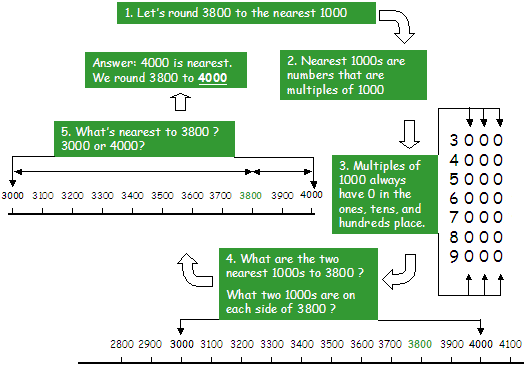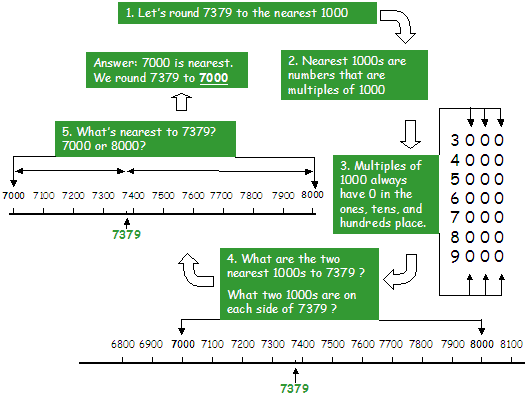The population of London in 2019 was around 9 million. Does that mean that its population is exactly 9 million? No, not so. Look carefully at the word around before 9 million. This means the population of London is somewhere near the number 9 million. It can be slightly less than 9 million or it can be greater than 9 million. This is called rounding off a number.
So, how do you round off a number. We have learned about the place values of a number. These can be ones, tens, hundreds, thousands and furthermore. When rounding off a number, it is this place value that helps us determine where to round off a number.
So, how do we decide how to round off a number to the nearest 1000?
Before understanding the rules to round off a number, it is important to understand what does rounding off to 1000 mean?
It means that we wish to round off the last four digits of a number, i.e. up to the thousands place of a number.
Rounding Up vs Rounding Down
Rounding Up
If the number at the thousand’s place is followed by 5, 6, 7, 8, or 9, the number is rounded up.
Example – We want to round off 613629 to the nearest 1000.
1. Look for the digit at the thousand’s place. It is 3.

2. Now look for the digit to the right of the digit at the thousand’s place i.e. the hundred’s place of the number. The number is 6.

3. Since this number is greater than 5, we round up the number, i.e. we round it off to the nearest 1000 that comes next to this number. So, 629 becomes 1000 which on adding to 3 at the thousand’s place, becomes 4000.
Hence, the number 613629 after being rounded off to the nearest 100 is 614000
Note : Here we moved up the number to the nearest thousand, which is why it is called rounding up.
Let us take another example.
Example – We want to round off 9815810 to the nearest 1000.
1. Look for the digit at the thousand’s place. It is 5.

2. Now look for the digit to the right of the digit at the thousand’s place. The number is 8

3. Since this number is than 5, we round up the number, i.e. we round it off to the nearest 100 that comes next to this number. So, 810 becomes 1000 which on adding to 5 at the thousand’s place, becomes 6000.
Hence, the number 985810 after being rounded off to the nearest 100 is 9816000
Rounding Down
If the number at the hundred’s place is followed by 0, 1, 2, 3 or 4, the number is rounded up.
Example – We want to round off 104328 to the nearest 1000.
1. Look for the digit at the thousand’s place. It is 4.

2. Now look for the digit to the right of the digit at the thousand’s place. The number is 3.

3. Since this number is less than 5, we round down the number, i.e. we round it off to the nearest 1000 that comes next to this number. So, 328 becomes 000 which on adding to 4 at the thousand’s place, becomes 4000.
Hence, the number 24615 after being rounded off to the nearest 100 is 104000.
Note : Here we moved down the number to the nearest hundred, which is why it is called rounding down.
Let us consider another example
Example – We want to round off 470138 to the nearest 100.
1. Look for the digit at the thousand’s place. It is 0.

2. Now look for the digit to the right of the digit at the thousand’s place. The number is 1.

3. Since this number is less than 5, we round down the number, i.e. we round it off to the nearest 100 that comes next to this number. So, 138 becomes 000 which on adding to 0 at the thousand’s place, becomes 0000.
Hence, the number 470138 after being rounded off to the nearest 100 is 470000.
Graphical Representation
Rounding off to the nearest 1000 can also be understood graphically as shown below
First it should be understood that when you are rounding off to the nearest 1000, the digit at the thousand’s place needs to be looked into.
Let us take a number 7348
This number lies between 7000 and 8000. To round off this number, either we take it back to 700 or move it forward to 800. How do we decide where to go?
Look at the number line below:

The numbers that lie in the red areas will be rounded down to 7000. Similarly, the numbers that lie in the blue areas will be rounded up to 8000. This is because the numbers that lie in red areas, i.e. the numbers between 7001 and 7499 are closer to 7000 as compared to 8000. Hence they will be rounded down.
However, the numbers that lie between 7500 and 7999 are closer to 8000 due to which they would be rounded up to 8000.
Remember
When rounding off a number to the nearest thousand, look at the HUNDREDS’S DIGIT of the number.
- If that digit is 0, 1, 2, 3, or 4, you will round down to the previous thousand (Round down)
- If that digit is 5, 6, 7, 8, or 9, you will round up to the next thousand. (Round Up)
Some More Examples
Let us round off these numbers to the nearest 1000
1. 62116 Number after rounding off to the nearest 100 62000
2. 84345 Number after rounding off to the nearest 100 84300
3. 19562 Number after rounding off to the nearest 100 20000
4. 10160 Number after rounding off to the nearest 100 10000
5. 45601 Number after rounding off to the nearest 100 46000
6. 10945 Number after rounding off to the nearest 100 10000
7. 2264 Number after rounding off to the nearest 100 2000
8. 1419 Number after rounding off to the nearest 100 1000
9. 22366 Number after rounding off to the nearest 100 22000
10. 36258 Number after rounding off to the nearest 100 36000
A graphical representation of rounding off to the nearest 1000 has been presented below for better understanding.
The diameter of the earth at the equator is 12,756 kilometers. That’s not an easy number to remember but if someone asked you what the approximate distance was you could probably remember that it’s about 13,000 kilometers. You’d get that number by rounding to the nearest thousand. Below are two other examples showing rounding to the nearest thousand.
Note: You can use this rounding calculator at the foot of this page to round a number to the nearest 1,000.
Rule for rounding to the nearest 1000

Look at the number in the hundred’s place and…
Review the examples below to see how to round to the nearest 1000.
Example 1:

Example 2:

How to round to the nearest 1000
| Steps | Ex. 1 | Ex. 2 | Ex. 3 | Ex. 4 |
| Let’s round a number to the nearest 1000. | 3,777 | 23,698 | 43,459 | 268 |
| Underline the hundred’s place. | 3,777 | 23,698 | 43,459 | 268 |
| If it is less than 5, round down. | 43,000 | 0 | ||
| If it is 5 or more, round up. | 4,000 | 24,000 | ||
| Pictorially |
Rounding Calculator
Rounding Calculator
rounded to the nearest
is
More Rounding Help
To the nearest 10 To the nearest 100 Larger numbers With decimals
Recommended Worksheets
Rounding Whole Numbers (Tens and Hundreds) (Sea Animals Themed) Worksheets
Rounding Whole Numbers and Decimals (Basketball Themed) Worksheets
Rounding Whole Numbers to the Nearest Tens and Hundreds 3rd Grade Math Worksheets









